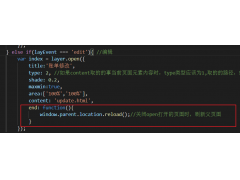How to render a Vue VNode to a String(如何将 Vue VNode 渲染为字符串)
问题描述
I'm trying to use a CSS mask in my Vue component. I need to complete the implementation of the toSvg function below. This will render the Vue VNode coming from this.$slots.default to an SVG string.
<script>
export default {
computed: {
maskImage() {
const svg = this.toSvg(this.$slots.default);
const encodedSvg = btoa(svg);
return `url('data:image/svg+xml;base64,${encodedSvg}')`;
},
},
methods: {
toSvg(vnode) {
// TODO: How can I convert the VNode to a string like the one below?
// In React, I could use const svg = ReactDOMServer.renderToStaticMarkup(vnode);
return `<svg viewBox="0 0 260 68" xmlns="http://www.w3.org/2000/svg">
<rect x="80" y="32" width="160" height="12" rx="2" />
<rect width="180" height="20" rx="2" />
<rect x="80" y="52" width="95" height="12" rx="2" />
<rect y="26" width="68" height="42" rx="2" />
</svg>`;
},
},
render(createElement) {
return createElement("div", {
attrs: {
class: "skeleton",
style: `-webkit-mask-image: ${this.maskImage}; mask-image: ${this.maskImage};`,
},
});
},
};
</script>
<style lang="scss">
.skeleton {
animation: skeleton-animation 2s infinite linear;
background: linear-gradient(to right, hsl(30, 1, 99) 0%, hsl(30, 2, 95) 30%, hsl(30, 2, 95) 70%, hsl(30, 1, 99) 100%) 0 0 / 200% 100% hsl(30, 2, 95);
overflow: hidden;
position: relative;
width: 200px;
height: 100px;
@keyframes skeleton-animation {
100% {
background-position: -200% 0;
}
}
}
</style>
Usage example:
<u-skeleton>
<svg viewBox="0 0 260 68" xmlns="http://www.w3.org/2000/svg">
<rect x="80" y="32" width="160" height="12" rx="2" />
<rect width="180" height="20" rx="2" />
<rect x="80" y="52" width="95" height="12" rx="2" />
<rect y="26" width="68" height="42" rx="2" />
</svg>
</u-skeleton>
Shows as:
Uses Vue.extend to construct one SVG component constructor, inside render function of the constructor, it renders slots.default.
Next step is create its instance, then mount() and get the compiled html.
Vue.component('v-test', {
computed: {
maskImage() {
let vnodes = this.$slots.default
let SVGConstructor = Vue.extend({
render: function (h, context) {
return h('svg', {
attrs: {
xmlns: 'http://www.w3.org/2000/svg'
}
}, vnodes)
}
})
let instance = new SVGConstructor()
instance.$mount()
const encodedSvg = btoa(instance.$el.outerHTML);
return `url('data:image/svg+xml;base64,${encodedSvg}')`;
}
},
render(createElement) {
return createElement("div", {
attrs: {
class: "skeleton",
style: `-webkit-mask-image: ${this.maskImage}; mask-image: ${this.maskImage};`,
},
})
},
})
new Vue({
el: '#app'
})
.skeleton {
animation: skeleton-animation 2s infinite linear;
background: linear-gradient(to right, #fcfcfc 0%, #f3f2f2 30%, #f3f2f2 70%, #fcfcfc 100%) 0 0 / 200% 100% #f3f2f2;
overflow: hidden;
position: relative;
width: 200px;
height: 100px;
}
@keyframes skeleton-animation {
100% {
background-position: -200% 0;
}
}
<script src="aHR0cHM6Ly9jZG5qcy5jbG91ZGZsYXJlLmNvbS9hamF4L2xpYnMvdnVlLzIuNS4xNy92dWUuanM="></script>
<div id="app">
<v-test>
<svg viewBox="0 0 260 68" xmlns="http://www.w3.org/2000/svg">
<rect x="80" y="32" width="160" height="12" rx="2" />
<rect width="180" height="20" rx="2" />
<rect x="80" y="52" width="95" height="12" rx="2" />
<rect y="26" width="68" height="42" rx="2" />
</svg>
</v-test>
<hr>
<v-test>
<svg viewBox="0 0 260 68" x="0" y="0" xmlns="http://www.w3.org/2000/svg">
<rect x="80" y="32" width="160" height="12" rx="2" />
<rect width="180" height="20" rx="2" />
<rect x="80" y="52" width="95" height="12" rx="2" />
<rect y="26" width="68" height="42" rx="2" />
</svg>
<svg viewBox="0 0 260 68" x="20" y="-20" xmlns="http://www.w3.org/2000/svg">
<rect x="80" y="32" width="160" height="12" rx="2" />
<rect width="180" height="20" rx="2" />
<rect x="80" y="52" width="95" height="12" rx="2" />
<rect y="26" width="68" height="42" rx="2" />
</svg>
</v-test>
</div>
这篇关于如何将 Vue VNode 渲染为字符串的文章就介绍到这了,希望我们推荐的答案对大家有所帮助,也希望大家多多支持编程学习网!
本文标题为:如何将 Vue VNode 渲染为字符串


- 从原点悬停时触发 translateY() 2022-01-01
- 在不使用循环的情况下查找数字数组中的一项 2022-01-01
- 为什么我的页面无法在 Github 上加载? 2022-01-01
- 如何向 ipc 渲染器发送添加回调 2022-01-01
- 如何调试 CSS/Javascript 悬停问题 2022-01-01
- 如何显示带有换行符的文本标签? 2022-01-01
- 为什么悬停在委托事件处理程序中不起作用? 2022-01-01
- 是否可以将标志传递给 Gulp 以使其以不同的方式 2022-01-01
- 使用 iframe URL 的 jQuery UI 对话框 2022-01-01
- 我不能使用 json 使用 react 向我的 web api 发出 Post 请求 2022-01-01









